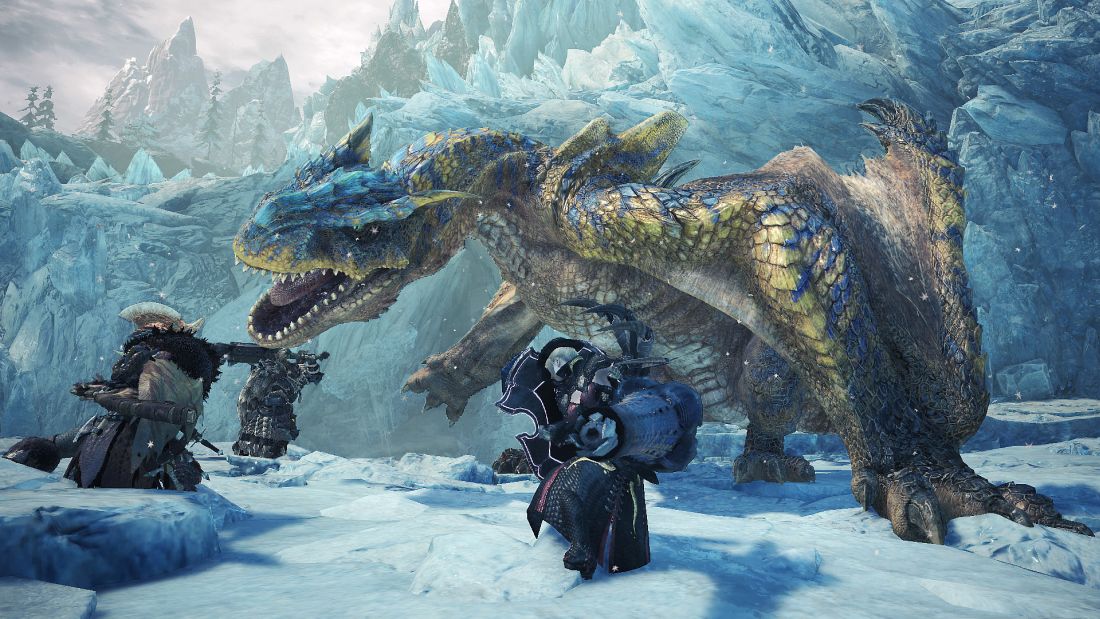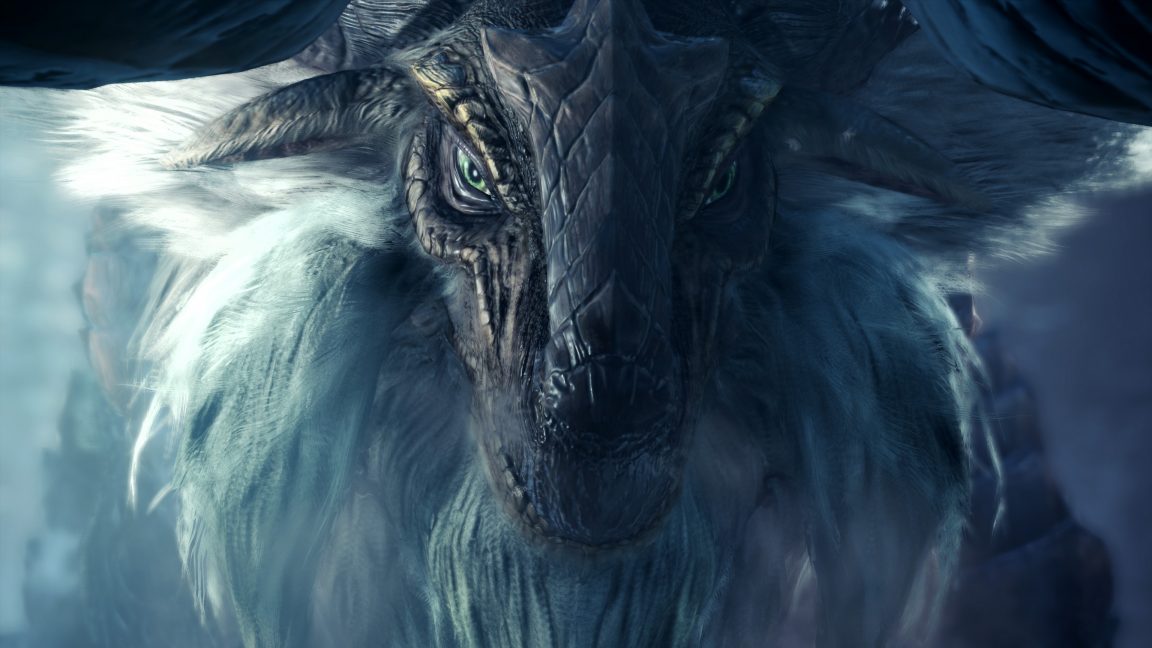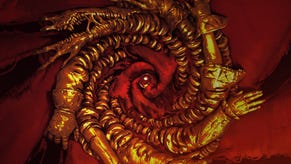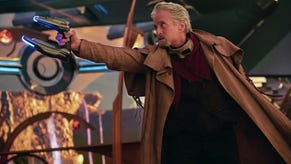An absolute beast of an interview about Monster Hunter World: Iceborne
Over a year since release, Capcom continues to push Monster Hunter World with the Iceborne expansion - considered so complete that it's being treated as an entirely new release.
The basics of Monster Hunter World: Iceborne are this - it adds a new location, the Hoarfrost Reach, as well as the new M Rank, and the storyline takes place after the main Monster Hunter World campaign. There are four main beasts to tackle; the Banbaro, Beotodus, the Nargacuga returns from previous Monster Hunter games, and the Velkhana - the true villain of the expansion.
To dive deeper into Iceborne, we sat down with producer Ryozo Tsujimoto and art director Kaname Fujioka, to discuss how a new biome changes Monster Hunter and influences new armour sets, how to use the clutch claw, faster travel around the map and what to do when approaching those M Rank beasts.
You can download the Iceborne beta right now, with the full expansion going live on September 6 for PS4 and Xbox One, and on PC later this year.
VG247: So obviously there's a lot of beasts in the game already and you're creating a new range of monsters. How do you ramp up the challenge when there's so many challenges in it already?
Ryozo Tsujimoto: Well, there's certainly a lot of challenges in the base game, not only from the low-rank and the high-rank main flow, but in the endgame we've been adding in things like Arch-Tempered monsters after the original game was released. We've been updating it with these kind of special challenges, where we're trying to flip the expectations of the hardcore players on the head by changing up how the monsters behave, and surprising them and forcing them into new tactics.
But they're the most challenging monsters in the base game. Iceborne isn't taking this concept necessarily. It's earning the Master Rank which fits in at both high ranks, so naturally the challenge will go up in scale, but it's more about how you see how the game has changed with the new additions, and the new area, and the new monsters that are found there. It is challenging to fit it in and slot it in on top of the original game in a way that makes sense for players who are going to play through - whether they did it in Monster Hunter World when it came out or whether they're now starting from scratch. So I think that, yes, it's not necessarily something that you're going to be going in on the first quest. It's difficult, it's the most difficult thing at the end of the world, so you want to have a good difficulty curve, get people up to speed. You'll still be able to use your gear that you've made at the end of High Rank in Iceborne, and you're going to gradually start gathering Master Rank gear parts, because you'll be challenging the Master Rank monsters and start replacing your gear with even more powerful weapons and armour, that will be a really good way for you to take on the challenges that are waiting.
VG247:How do you keep doing something different in a game with such a large range of monsters from a visual perspective?
Ryozo Tsujimoto: Well, the most immediate refreshing change in terms of visuals is the fact that we've got a new area added, the Hoarfrost Reach. And a cold climate was one of the biomes we didn't have in Monster Hunter World. We had a variety of green vegetative areas - green vegetation areas, deserts, and so forth. So this is already going to start looking quite impactful to players, especially because of things like the armour is looking like it's getting you ready for a cold climate and you feel that change. And the monsters too, I've designed them so they look like they fit in with this ecosystem. Because we always start off with the ecosystem itself, we create an environment and we try to make it a realistically structured environment, so we design which monsters are going to be the low-level fodder for the other monsters, and the sort of food chain, and then the monsters that we plop into that environment will look convincingly like they've actually adapted themselves to living in this harsh climate, and how they interact with the other monsters in the area. How we present those monsters to you in what I would call level design, so, you know, which ones you see first and in which order, how they interact with each other I think is a big sea change from the existing game, because clearly it's going to be a completely new area, completely new monsters being thrown at you, that'll keep it very fresh.
VG247: You just said how they start with the environment, then create the monsters to suit the environment. Is that the same with the armour sets? Do you create the monster and then think, how's the armour going to look like from the skin of that animal?
Ryozo Tsujimoto: Yes, absolutely. We have to take it in that order. So the areas will define the monster designs, and the monster designs will inform the armour designs. You can't start from that side of things. We want it to look more or less convincing within reason that we actually took parts of the animals' hide and bones and so forth, and combined it with some various generic parts that you collect, and it looks like, oh you took the hide on this part of the monster's body and you made it into new armour, part of a chest plate, or you made sort of tanned leather to make these parts. If you do it the other way around I think it wouldn't really look organic as part of the hunter life that we depict, where people in the game depend on the ecosystem for all the resources that they have, whether that be for survival like protection, or offence as well.
VG247: Can we talk a bit about the clutch claw mechanic, which is new, right? Why they added it in?
Ryozo Tsujimoto: Well, the initial impetus to add this system was that in Monster Hunter World we already had the idea of trying to use the environment to control the monster's positioning to your advantage, so whether that would be using the slinger mechanic to, say, shoot seeds at a vine holding up rocks, and then the rocks fall down and hit the monster, or being able to try and get the monster to go where you want to be on the stage so you could attack it, whether that would mean knocking it over and so forth. That was something you could do indirectly using the environment in the base game. Now for the expansion I wanted to add something that lets you be a bit more direct in how you control the monster's position. So by being able to use the clutch claw to grapple onto the monster, you can actually take control of that part of your strategy, and it gives you more choices to use during any battle. Because you can use it with any weapon - it's not a new weapon - it's a mechanic that applies to all fourteen weapon types. And because you can use it while the weapon is unsheathed as well, you don't even have to switch between your weapon and the clutch claw, you can just make it an option that you can bust out at any time when you think the strategy makes sense.
So it's a great addition to your strategic arsenal because once you grapple onto the monster and attack it, you can do things like soften up the monster's hide in that spot, and that'll actually look visually like damage, which the other players then know is the signal that they - the other players in your team - if they attack there, they'll do extra damage. Or you can send the monster - if they attack it in a way to send the monster flying, if you're on this side and send the monster flying that way, into a wall, or maybe you've set a trap or your teammates have set a trap and you're going to push the monster into it. It's very flexible in terms of strategy. At the same time I don't want to make it sound like this is the ultimate option to just spam and win now. You're going to have to find the right timing to use it. If a monster is charging around angry and you clutch claw onto it, you're going to get - it's like similar to the mounting, where if you're not doing it at the right timing, you just get thrown off or you won't get much of a chance to attack it. Or the claw won't even connect in the first place, so you will still need to make sure that as with all weapons in the game, you're choosing the right moment to make a strategic decision to use this device.
VG247: What about the addition of the raider ride mechanic? What was the thinking behind adding that in?
Ryozo Tsujimoto: I like this feature because it ties in with the new area being quite large. It's bigger than any of the existing individual maps in Monster Hunter World, and it's going to sort of be gradually revealed and unlocked to you progress through the story. Once you realise how big it is I think you wouldn't want it to be too big and it's actually tedious to get around, so we already had those shortcuts in the base game for things like using a slinger to grab onto a Wingdrake to get flown around a little bit, or even just finding literal physical area shortcuts. But this Tailraider mechanic where previously only the Palico cat companions could jump on a monster and ride around on it has been expanded, so now hunters can do that too. While you're not directly controlling the monster, it's actually going to be finding things like the tracks that the Scoutflies already trod, and that means that by following them it'll bring you to the monster quicker, and you've actually got a little bit of downtime while you're on there, so it's a good time to do some prep. So you can sharpen your weapon while you're on the Tailrider, you can take a hot drink for the cold or take a potion, so it's a good chance for you to not only get there faster but do the things you need to do before you get into the action.
VG247: Is that part of the customisation in Monster Hunter as well? Because obviously you can choose your armour sets and stuff. Can you choose what creature you're riding around on, or...?
Ryozo Tsujimoto: Well, it isn't like it's like the Palicos, where you have one back at your base and you choose it, and you go out with it, it's actually something that occurs on the map. So small monsters within the map are designated as the ones that the Palicos can ride in the first place. So it is based on that existing Tailride mechanic. Once your Palicos have become friendly with the local wildcats, the Grimalkynes within the area, they'll teach your Palicos how to summon and make friends with these small monsters. And then that is expanded now where you can now ride on the same monsters. So it'll depend which small monsters are available locally.
VG247: So different maps have different monsters?
Ryozo Tsujimoto: Yes, different parts of the map might have different ones available. In addition to be able to just let it track the monster you're currently after, you can even open up your map and put a waypoint and ask for it to go there for you.
VG247: Can we also talk about the addition of gem slots on Mantles?
Ryozo Tsujimoto: Well, the Mantle system was already in Monster Hunter World and different ones have different effects, but I think that over the course of playing the game for so long players will essentially finalise their strategies for which Mantle you take for which monster, or which quest. So I didn't want it to be like they just take exactly the same thing over when you get to Iceborne - bring something new. So you'll be able to upgrade and strengthen your Mantles this time around, and as part of that, adding in the slot system which people remember, it'll let you upgrade. Each will now have a different way of upgrading it, and I think it just, again, it puts more cards in the player's deck for what they want to pull out.
VG247: When it comes to the Master Rank monsters, because obviously they've refreshed the older monsters with Master Rank versions, have they just got a larger health pool or is there new behaviours and that sort of thing?
Ryozo Tsujimoto: Yes, I mean of course being at Master Rank they're going to be stronger in terms of stats, but existing monsters will also have some new tricks up their sleeves that will be in line with the fact that this harder rank is not just about a harder wall or harder hurdle to reach in terms of how much damage you do. You've got to be more on your toes, use your strategies more effectively. Whenever the old monsters bust out new moves or behaviours, it'll be a nice surprise for fans. It'll keep them on their toes and give them something new to try and work out.
VG247: Can you give me an example of one of the new skills of one of the classic monsters?
Ryozo Tsujimoto: Well, one example is, if you've played the demo we have here already, there are three quests at Great Jagras with the beginner. People are probably sleeping on it a bit because they want to check out the new ones.
VG247: Yes, that's what I did.
Ryozo Tsujimoto: Even somewhat of the original earlier monsters like Great Jagras has got new abilities and behaviours like it toughens up a bit, it's able to, if you remember whenever it consumes nearby other monsters it's able to blow out its belly and that makes it larger and more dangerous. It's able to maintain that status for longer which makes it more of a threat, and its bodyslam that it can do during that will do more damage, so even if you think you've seen it all before with the earlier monsters, I think they'll be able to surprise you and cause you problems.
VG247: I was just wondering if we're going to get more expansions and that down the line? Do you plan on supporting the game for much longer after this?
Kaname Fujioka: We do plan to have post-launch support for Iceborne with the same system as you had with Monster Hunter World, with bringing regular title updates that bring balance changes, bug fixes, event quests and so forth. I mean sometimes they add new monsters...













